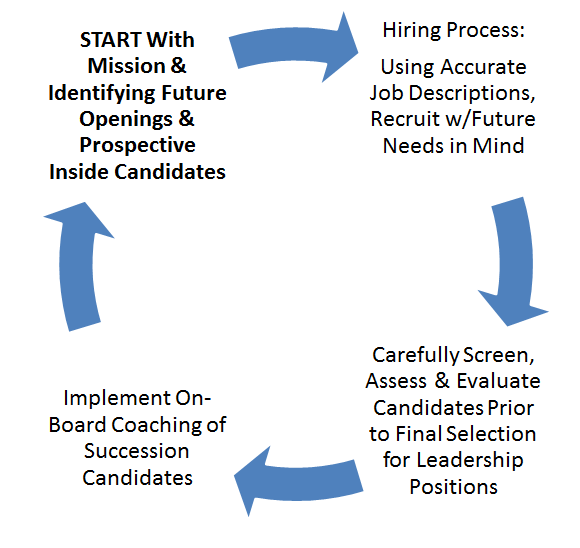Many transitions and changes occur in business. Mergers, acquisitions, restructurings, downsizings and closings are a few, but one that many companies are facing or preparing for these days is Succession Planning, replacing their key executives and employees in critical roles.
 As Baby Boomers — the oldest and, up to now, the largest workforce generation — begins retiring, their leadership positions are left waiting to be filled. This generation has actually been one to work or plan to work longer than some other generations. At one time, past generations began retiring at age 55 or 60, but now many are working past 65 and into their 70’s. Still, sooner or later, their positions need to be replaced.
As Baby Boomers — the oldest and, up to now, the largest workforce generation — begins retiring, their leadership positions are left waiting to be filled. This generation has actually been one to work or plan to work longer than some other generations. At one time, past generations began retiring at age 55 or 60, but now many are working past 65 and into their 70’s. Still, sooner or later, their positions need to be replaced.
In the past several years, the unpredictable economy has led a majority of retirement-age employees to put off their retirement. This caused many companies to postpone implementing their Succession Plan. Some businesses haven’t even developed a Succession Plan, which could be risky. However, now that more of the workforce is retiring, more businesses are taking steps to prepare for this BIG transition. One of the wisest decisions in preparing for succession planning is to select an impartial facilitator for this important transition.
Talent Management is the process of developing employees with strong potential for career growth, including potential company leaders. The Succession Planning Process is an ongoing program and the Talent Management Process is a big part of this program. Talent Management is the program that selects and trains those candidates filling the positions of exiting executives/leaders. Even after the training, executive coaches and designated company representatives should follow up and evaluate how well these new leaders are performing.
TALENT MANAGEMENT ASPECT OF A SUCCESSION PLAN

One other point to make about Succession Planning: Not all retiring employees want to totally retire. Some other options include:
- Phased retirement, where employees gradually transition out of their work routine while training or mentoring their replacements. This can last 1, 3, 6 months or longer.
- Others choose to follow another passion of theirs – an alternative career, going into a totally new career, which can be part-time or full-time.
- Still others may decide to become self-employed, selecting a business in which they have a strong interest, talent, or passion.
- Yet others may sign up for a part-time position or temporary positions.
- Then there are those who prefer to volunteer in an area or industry they value.
- Finally, there are those who delight in more leisure and/or travel.
Whatever exiting employees choose to do, it is good for them to know that they have a choice. Phased retirement can be one avenue that a company offers that can benefit both the employee and employer.
However you implement it, the two keys to a successful Succession Plan:
- Have a plan, and
- Carefully choose an experienced transition expert for this transition!
Core decision makers for the company will appreciate having an expert to walk them through this process and help them avoid anything falling between the cracks.
Robyn Crigger is Managing Partner, OI Global Partners – Compass Career Management Solutions in Charlotte, NC. Trained and experienced in various Human Resources areas from assessments to executive coaching, Robyn strives to provide professional assistance to both companies and individuals faced with transitions.
Share this post:


No responses yet